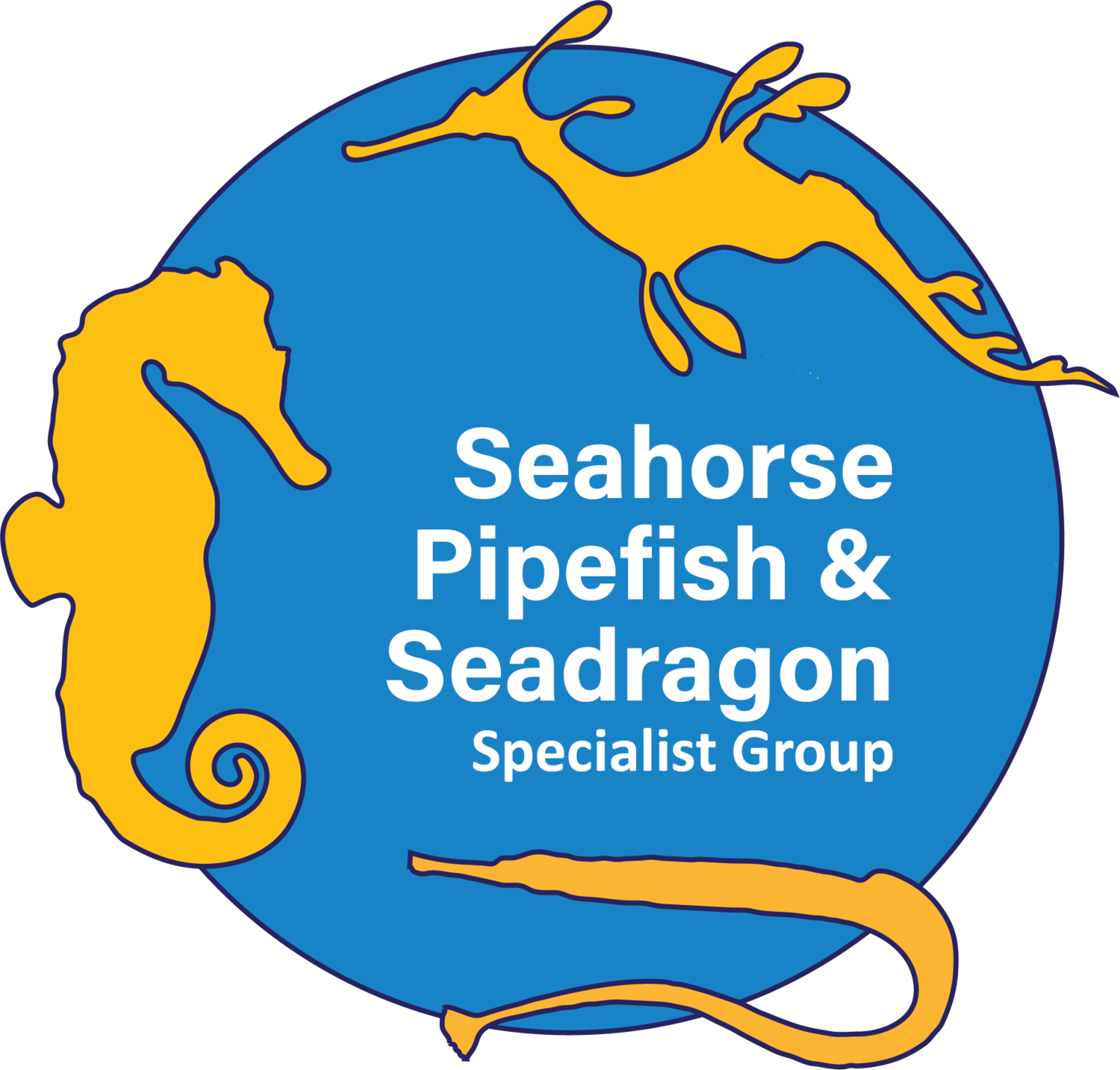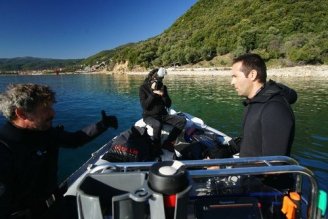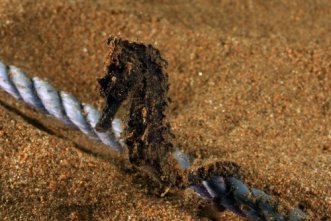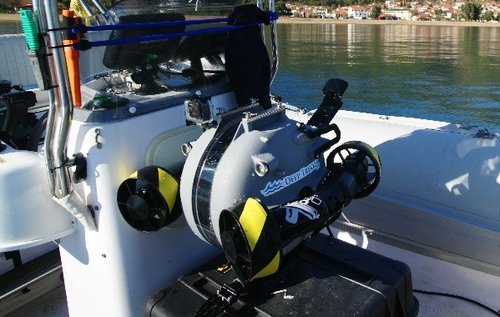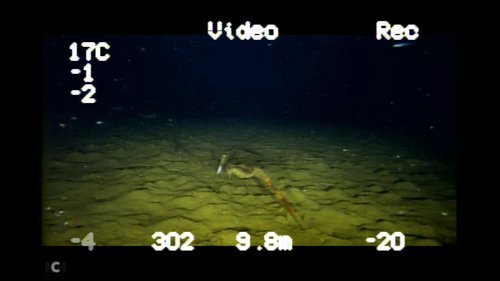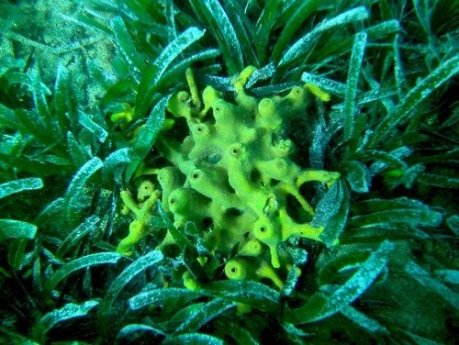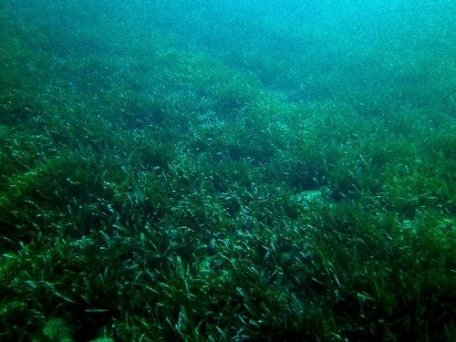By Dr. Miguel Correia, Regional Focal Point for Europe for the IUCN Seahorse, Pipefish and Seadragon Specialist Group, iSeahorse National Seahorse Expert
Stratoni is a small village located in the north-eastern part of Greece. Most of the local community works in a mining factory located near the shore line. The landscape is beautiful with irregular mineral rich mountains that rest in the sometimes rough shores of the Mediterranean waters. On arriving in Greece in the midst of Ana’s storm I was worried about what I would find when I went to look at the treasure that lays beneath the sea.
I went to Greece after a call from Vasilis Mentogiannis*, a professional archaeological diver who contacted Project Seahorse to urge us to protect a local seahorse population. As I was not aware of any seahorse population in Greece (apart from some rare occasional sightings), I was very curious about this intriguing story. Vasilis and his team have been monitoring this population since 2007, when they first saw seahorses on an exploratory dive while searching for archaeological antiquities. Following a large storm in 2010, the bottom cover of the seahorse habitat was covered by the mountain’s sediment run-off from the small creeks. This event dramatically changed the seahorse habitat and threatened the existence of that seahorse population. The following month, Vasilis went back to monitor the area and was pleasantly surprised to find seahorses in a now barren area. Vasilis and his team felt the need to help these seahorses. More recently in 2016, a set of different artificial holdfast were deployed to help seahorses grasp in an area very impacted by waves. These artificial holdfasts were mostly made of ropes and have been used by the seahorses since then. Over the years, Vasilis and his team became passionate about these charismatic creatures and they have engaged in protecting them and raising awareness in the local community, with the support of several entities.
The first dive in the artificial holdfast area
The morning after I arrived in beautiful Stratoni, Vasilis and his colleague Anastasis took me diving. Vasilis and Anastasis were eager to show me the local seahorses at their custom-made artificial structures. As experienced archaeological divers, the two dive buddies brought with them all their high-tech gear to photograph and record the seahorses. It was with a mixture of surprise and amazement that I saw the first seahorse – a small Hippocampus hippocampus grasping the team’s previously deployed artificial holdfast. After a quick swim, another seahorse, and then another… six seahorses in total including H. guttulatus too! At the end of the first dive I felt honored to be able to witness first-hand what could possibly be the first recording of a fairly big seahorse population in a brand-new location. No such records had been seen in any other part of Greece. Amazing! Many questions arose. Why are the seahorses coming to a completely barren location for those artificial holdfasts? Where are they coming from? These questions got stuck at the back of my mind.
Technology as a research tool
Night came and Vasilis wanted to test something. “We should take the ROV (remotely operated underwater vehicle) to the seahorse site and record what is happening during the night and what creatures we can see near the seahorse area”. The night was cold but the sea remained calm. Not even a small wave disturbed the sea surface. After reaching the site, carefully indicated by a small yellow buoy, the team prepared the ROV. The remote-controlled vehicle was carefully placed in the water and Vasilis did the rest. On arrival at the location the ROV spotted the first seahorse grasping the base of the artificial structure. “Now we wait!” said Vasilis, grabbing a cup of coffee. The small seahorse, standing in the middle of the spot light, was seemingly unconcerned about this strange object and remained still, looking around with both independent oriented eyes. Suddenly a myriad small crustaceans gathered around the light dancing and circling the area. After 15 mins, the first sparid fish approached the ROV, keeping a safe distance but apparently feasting on this abundance of food. Twenty minutes passed and a small H. hippocampus appeared, adding to this special moment. The coffee ran out, and the cold started to get the best of us. We happily gathered all the gear and headed back to the dock, drunk on the magical images we had just seen. What a fantastic experience!
Luxurious seagrass
The next day, it was time to test a hypothesis. Could the seahorses we had found come from a nearby area covered by a seagrass bed (Posidonia sp.)? “It is time for you to test the scooter” said Vasilis. “It will help you cover a wider area with little effort”. I felt uneasy as it was my first time to try such a machine, but curiosity made me go. Anastasis guided me to the area while I did my best to find seahorses amongst the seagrass. The luxurious seagrass bed was home to many organisms such as sea cucumbers, sea urchins, tunicates, sea stars and many fish species. After a 60-minute dive, and taking full advantage of the scooter, the result was puzzling. No seahorses! So, why were there no seahorses in a supposedly adequate and preferred habitat, and instead they were occupying a mostly barren location…?? Time to tackle this question. Vasilis and Anastasis were happy to see someone sharing their thoughts and passion. We brainstormed during the day, coming up with ideas and plans for the future. Endless possibilities! This could possibly be the perfect place to do a case study of these Mediterranean seahorse populations.
Exploring new areas
My stay in Stratoni was coming to an end. I had only one day left to dive. We decided that we would do a free dive, no plans, just to feel the pulse of the underwater surroundings. I loved the idea and (professional default) I chose to do a quick survey of the area near the artificial holdfasts. I took a 100m transect tape and followed east, keeping parallel to the shore. Nothing, just sediment, runoff from the metal enriched mountains, no holdfasts, no seahorses. I changed my bearing and went south, to deeper waters. I started to see some tube worms (Sabella sp.) and suddenly I saw the first seahorse, a H. guttulatus. The more I searched, the more seahorses I found, each holding onto its own worm tube. Two, three, four… ten! While I was recording these findings with my underwater camera, I saw Vasilis approaching me. “10!” I signaled with both hands- a full set of fingers enthusiastically pointing up. He didn’t budge in disbelief. I continued my search and left Vasilis now busy photographing two seahorses that were nearby. Then I saw the eleventh, the twelve… sixteen overall! I was a very happy man!
Greece in my heart
During my stay in Stratoni, Vasilis introduced me to the local people. I felt their genuineness, they always having a big smile on their face. I felt welcomed and somewhat a part of the community, even for a short period of time. It was time to leave. I felt confident and optimistic for the future. The engagement of some extraordinary people was the living testimony of the effectiveness of citizen science in the quest of protecting such a charismatic but vulnerable species. The passion of this archeological research team has proven to be the key for the protection of Stratoni seahorses.
*Vasilis Mentogiannis is an iSeahorse Ambassador
Photos by Vasilis Mentogiannis and Miguel Correia
(Cross-posted on Project Seahorse’s blog, On conservation)
